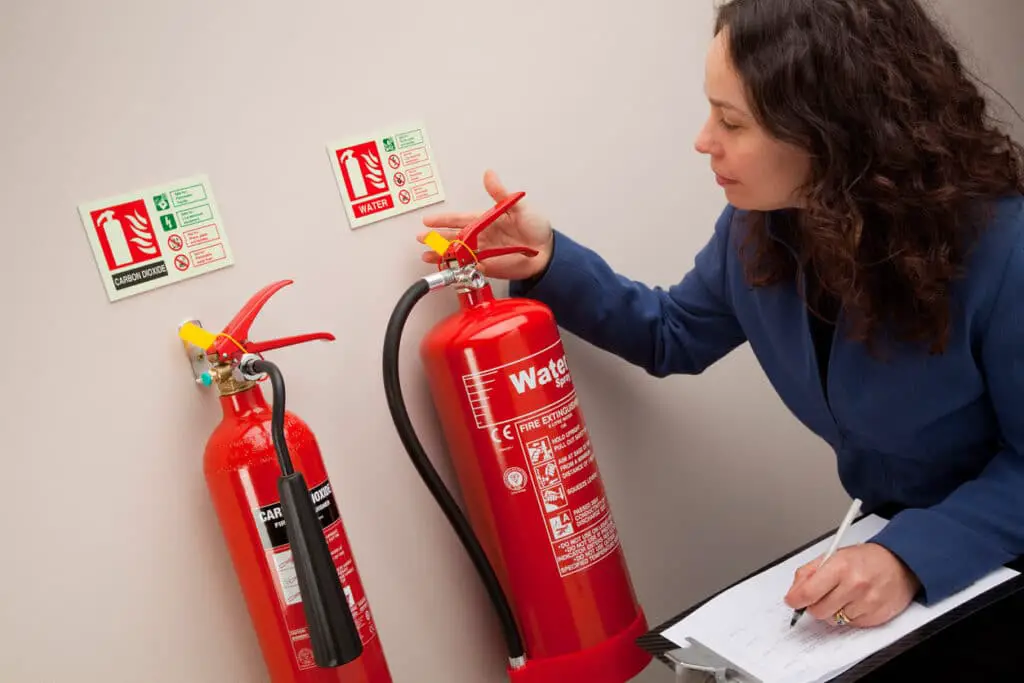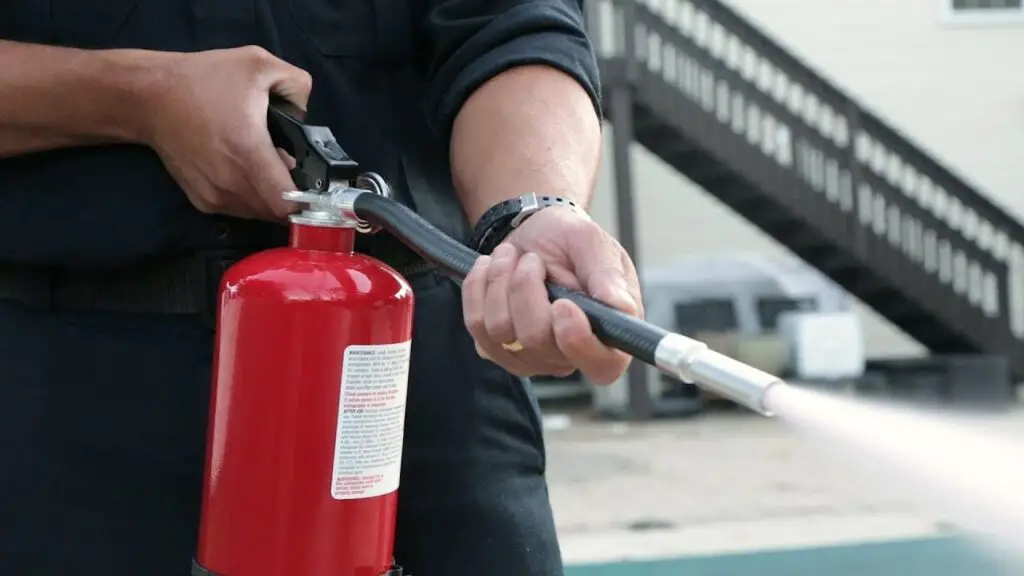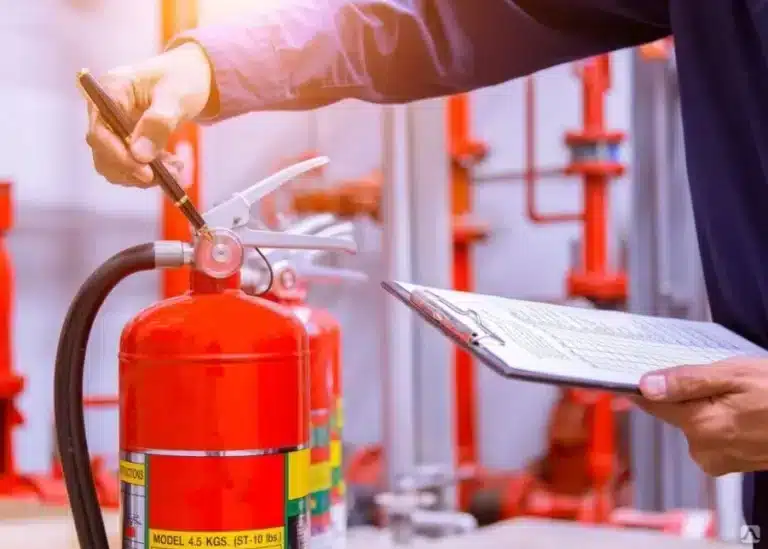Introduction
How To Mount A Fire Extinguisher: Mounting a fire extinguisher in your home or workplace is an essential safety measure that can save lives and protect property in the event of a fire emergency .Fire extinguishers are portable devices that put out small fires before they grow. Fire extinguishers must be equipped and accessible for emergency use.
First and foremost, we will discuss the importance of choosing the right location for the fire extinguisher, considering factors such as accessibility, visibility, and proximity to potential fire hazards. We’ll examine fire extinguishers in kitchens, garages, workshops, and offices. The tools and materials required for mounting a fire extinguisher, such as brackets, screws, and anchors. We will provide detailed instructions on how to install the mounting bracket securely to the wall or other suitable surfaces.
Additionally, we will address the importance of ensuring electrical fire the correct height for mounting the extinguisher, following relevant guidelines and regulations. These measures will help ensure the extinguisher remains in optimal condition and ready for use whenever necessary. You can mount a fire extinguisher properly by following this tutorial, improving your environment’s safety and your and others’ peace of mind.

How to mount fire extinguishers?
To prevent movement or damage, fire extinguishers should be mounted on brackets or in wall cabinets with their handles 3-1/2 to 5 feet above the floor, depending on type. Gross weights under 40 pounds
Fire extinguishers should be located strategically and conveniently accessible for quick and effective usage in emergencies. Here are some fire extinguisher mounting guidelines:
Select the location: Fire extinguishers should be near kitchens, garages, workshops, and electronics. Make them visible and accessible.
Mount at the correct height: The recommended height for mounting fire extinguishers is between 3.5 and 5 feet above the floor. This allows for easy access for most individuals, including those with mobility limitations.
Use a mounting bracket: Install a sturdy mounting bracket specifically designed for the size and weight of the fire extinguisher. Secure the bracket to the wall or other surface with screws and anchors.
Consider visibility: Mount the fire extinguisher in a location where it can be easily seen, even from a distance. Use signage or labels to indicate its presence.
Follow regulations and guidelines: Different jurisdictions may have specific regulations regarding the mounting of fire extinguishers. Familiarize yourself with local codes and guidelines to ensure compliance.
Regularly inspect and maintain: Check the fire extinguisher periodically to ensure it remains in good working condition. Inspect for any signs of damage, leakage, or expired contents. Follow the manufacturer’s instructions for maintenance and recharge if necessary.
How does a fire extinguisher mount to wall?
Mounting the Extinguisher to the Wall
The bulk of our fire extinguishers have wall brackets, while the smaller ones have car brackets. Small hook with 2 wall screws is the wall mount.
Mounting a fire extinguisher to a wall requires the use of a mounting bracket specifically designed for this purpose. Here is a step-by-step guide on how to mount a fire extinguisher to a wall:
Choose the location: Select a suitable location for the fire extinguisher that is easily accessible and visible. Consider proximity to potential fire hazards and follow local regulations and guidelines.
Gather the necessary tools: You will need a mounting bracket, screws, anchors (if needed), a drill, and a screwdriver.
Position the bracket: Hold the mounting bracket against the wall at the desired height and mark the screw hole locations using a pencil or marker.
Drill pilot holes: Use a drill and the appropriate drill bit size to create pilot holes at the marked locations. Make sure the holes are slightly smaller than the screws.
Attach the bracket: Align the bracket with the pilot holes and insert screws through the bracket into the wall. Tighten them securely, ensuring the bracket is firmly attached.
Hang the fire extinguisher: Place the fire extinguisher into the mounted bracket, ensuring it sits securely and is not wobbly. Follow any additional instructions provided by the manufacturer for securing the extinguisher to the bracket.
Verify stability: Shake the fire extinguisher gently to verify it is securely installed.
Can you mount a fire extinguisher laying down?
A modern fire extinguisher can be stored horizontally. The contents are under pressure, and the angle of storage will not cause the system to leak.
Proper operation: The mechanisms and components of fire extinguishers use gravity and pressure. When mounted upright, the extinguisher’s contents, such as the extinguishing agent and propellant, are in their correct positions, allowing them to discharge properly when activated.
Visibility and accessibility: Mounting a fire extinguisher upright ensures its visibility and accessibility. In an emergency, it should be easily seen and reached for quick and efficient use. Mounting it horizontally or laying it down could make it less noticeable or hinder its accessibility, delaying the response time during a fire incident.
Instructions and labels: Fire extinguishers have labels and instructions printed on their bodies, providing essential information on proper usage, maintenance, and safety precautions. When mounted upright, these labels and instructions are readable and easily understood. Mounting the extinguisher laying down would make it challenging to read and follow the instructions correctly.
Safety concerns: Mounting a fire extinguisher in any other position than upright can pose safety risks. It may lead to leaks, improper discharge, or malfunctioning of the extinguisher. It could also cause damage to the extinguisher or its components, rendering it ineffective in combating a fire.
What is the distance between fire extinguishers and fire?
Always extinguish the incendiary material and not the flames. What is the advised distance to use a fire extinguisher from? Officially, it is between 8 and 12 feet if possible.
The distance between fire extinguishers and potential fire sources is an important consideration to ensure their accessibility and effectiveness. While there are no specific universal guidelines dictating the exact distance between fire extinguishers and potential fires, several factors should be taken into account:
Proximity: Fire extinguishers should be located in close proximity to potential fire hazards. This means placing them within reasonable reach of areas where fires are more likely to occur, such as kitchens, workshops, or areas with electrical equipment. The goal is to minimize the distance required to access and deploy the fire extinguisher during an emergency.
Visibility: Fire extinguishers should be clearly indicated. They should be visible and accessible without obstructions. Place them in prominent, visible positions to enhance their chances of being spotted and used quickly.
Regulations and guidelines: Local fire codes and regulations may provide specific recommendations regarding the placement of fire extinguishers. These guidelines often outline the maximum travel distance allowed to reach a fire extinguisher from any point within a building. Familiarize yourself with local regulations to ensure compliance.
User convenience: Consider the convenience and ease of access for individuals who may need to use the fire extinguisher. Avoid placing them at heights or locations that may be difficult to reach for some individuals, such as those with mobility limitations.
Where is the best place to install a fire extinguisher?
In most buildings, the best place for Fire Extinguisher Installation is near the main entrance. However, decide the placement depending on the hazards. For example, if you have a kitchen area in your building, you should install a class K-rated Fire extinguisher nearby.
The best place to install a fire extinguisher depends on several factors, including the layout of the space, potential fire hazards, and accessibility. Here are some general guidelines to consider when determining the ideal location for a fire extinguisher:
Kitchen: Fires often start in the kitchen. A fire extinguisher must be visible and accessible, away from heat sources but within reach, to swiftly extinguish a kitchen fire.
Near fire hazards: Identify areas with potential fire hazards, such as workshops, garages, or electrical equipment rooms. Mount fire extinguishers in these locations to provide immediate access in case of a fire related to these hazards.
High-risk areas: Areas with a higher likelihood of fire incidents, such as storage rooms or areas with flammable materials, should have fire extinguishers installed nearby. Ensure they are within easy reach and clearly visible.
Exits and escape routes: Installing fire extinguishers along escape routes, near exits, or in stairwells can provide an additional layer of safety during evacuations. This allows individuals to attempt fire suppression while exiting the building if it is safe to do so. Fire extinguishers should be installed in a conspicuous, clear area. Avoid placing them behind doors, furniture, or other objects that may hinder their visibility or accessibility during an emergency.
What is the NFPA standard for fire extinguisher installation?
The bottom of the extinguisher needs to be at least 4in off the ground and the top not more than 5ft from the ground, unless it is heavier than 40lbs. In the case where it is heavier than 40lbs, the top of the extinguisher cannot be more than 3.5ft above the floor.
The National Fire Protection Association (NFPA) provides guidelines and standards for fire safety, including fire extinguisher installation. The specific NFPA standard for fire extinguisher installation is NFPA 10: Standard for Portable Fire Extinguishers. This standard outlines the requirements and recommendations for the selection, installation, inspection, and maintenance of fire extinguishers.
NFPA 10 covers various aspects of fire extinguisher installation, including:
Placement: The standard provides guidelines on the placement of fire extinguishers based on the type of hazard and the size and capacity of the extinguisher. It recommends placing fire extinguishers in easily accessible locations, considering factors such as visibility, proximity to potential fire hazards, and maximum travel distance to reach the extinguisher.
Mounting: According to NFPA 10, fire extinguishers must be installed on a solid surface with certified brackets at the proper height and orientation.
Signage and labeling: The standard specifies the use of appropriate signage and labeling to identify the location of fire extinguishers, including visible labels indicating the type of fire extinguisher and any specific instructions or warnings.
Inspection and maintenance: NFPA 10 provides guidelines for regular inspection, testing, and maintenance of fire extinguishers to ensure they are in proper working condition. This includes requirements for visual inspections, pressure checks, and recharging or replacement when necessary.
Where do you store a fire extinguisher at home?
The extinguishers should be placed in areas that are accessible within seconds. Place them in easy-to-grab spots, near exits. The National Fire Protection Association recommends having at least one fire extinguisher on every floor of the home. The first location should be the kitchen.
When it comes to storing a fire extinguisher at home, it is crucial to choose a location that provides easy accessibility and visibility while considering safety precautions. Here are some recommendations for storing a fire extinguisher at home:
Garage or workshop: Consider installing a fire extinguisher in your garage or workshop with flammable materials or tools. It should be wall-mounted or on a shelf for easy access.
Bedroom or common areas: It may be beneficial to have a fire extinguisher on each level of the house, especially near sleeping areas or common gathering spaces. Mount them in visible locations along escape routes, such as hallways or stairwells.
Avoid obstructions: Clear the fire extinguisher of furniture, drapes, and other obstructions in case of an emergency. Clear the area around the extinguisher for visibility and reach.
Secure mounting: Use a mounting bracket or stand designed for fire extinguishers to keep them securely in place. This prevents accidental tipping or displacement and ensures they are readily available when needed.
Fire extinguishers use which gas?
Carbon dioxide
Carbon dioxide is incombustible and also does not support burning. Hence, it is used in fire extinguisher. When sprayed on burning object it stops the supply of oxygen and extinguishes fire.
Different types of fire extinguishers use various gases to extinguish different classes of fires. Here are some commonly used gases in fire extinguishers:
Carbon Dioxide (CO2): Class B (flammable liquids) and Class C (electrical) fire extinguishers employ non-flammable carbon dioxide. The oxygen displacement smothers the fire and prevents it from burning.
Dry Chemical Powder: Dry chemical powder extinguishers utilize a mixture of chemicals, such as monoammonium phosphate or sodium bicarbonate. These extinguishers are effective for Class A (ordinary combustibles), Class B, and Class C fires. The powder chemically interrupts the fire’s combustion process and creates a barrier between the fuel and oxygen.
Water: Water is used in fire extinguishers designed for Class A fires. These extinguishers are typically pressurized water extinguishers or water mist extinguishers. Water cools down the fire, absorbs heat, and suppresses the flames.
Halon: Halon gas was originally widely used for Class B and Class C fires, but environmental concerns have made it less popular. Halon chemically stops combustion, suppressing fires. Due to its ozone-depleting effects, numerous governments have banned it.

Conclusion
Mounting a fire extinguisher is a crucial step in fire safety preparedness, as it ensures that this life-saving device is readily accessible during an emergency. By selecting an appropriate location for the extinguisher, considering factors such as accessibility and visibility, you increase the chances of quickly responding to a fire incident. Proper installation of the mounting bracket using the right tools and materials ensures the extinguisher remains securely in place.
To guarantee easy reach and use, fire extinguishers should be installed at the correct height according to standards. Additionally, regularly inspecting and maintaining the extinguisher will guarantee its functionality and reliability when needed. Remember that mounting a fire extinguisher is just the first step in fire safety. It is equally important to educate yourself and others on how to use a fire extinguisher correctly. Familiarize yourself with the different types of fires and the appropriate extinguisher to use in each situation.
Conduct regular fire drills and ensure that everyone in the vicinity knows the location of the fire extinguisher and how to operate it. By taking these proactive measures, you contribute to a safer environment and empower yourself and others to handle fire emergencies effectively. Remember, prevention is key, and having a mounted fire extinguisher is an integral part of an overall fire safety plan. Stay vigilant, stay prepared, and prioritize the safety and well-being of yourself and those around you.

